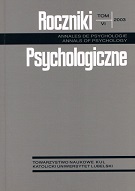Cechy osobowości i obraz siebie pacjentek z jadłowstrętem psychicznym (anorexia nervosa)
Personality traits and self-image in anorectic female patients
Author(s): Gustaw Kozak, Agnieszka KozakSubject(s): Psychology
Published by: Towarzystwo Naukowe KUL & Katolicki Uniwersytet Lubelski Jana Pawła II
Summary/Abstract: The paper seeks to answer the question what personalities, personality traits, are connect with anorexia nervosa. In the beginning the paper characterizes anorexia as a disorder together with the descriptions of female personalities that we find in literature. In the test the Adjective Check List ACL by H. G. Gough and A. B. Heilbrun has been used in its Polish translation and adaptation by Z. Płużek. The respondents filled it in its „I am” version. The group of female patients with anorexia consisted of 50 girls (the diagnosis of anorexia in conformity with ICD-10), aged 15-27. The control group consisted of 50 healthy girls (no diagnosis of anorexia or any other psychiatric diagnosis), aged 15-28. The test was carried out in the period of two years 2000/2001. The findings point to statistically essential differences (p≤0, 005) with regard to some dimensions of self-image between anorectic patients and healthy people. Anorectic female patients obtained lower results in the following subscales of the test: Fav, Nur, Aff, Het, Exh, S-Cfd, P-Adj, Iss, Np, A-3. Essentially higher results for this group have been obtained in the following subscales: Aba, Crs, Ac, A-2. As regards the mean results in scales ACL, a profile of personality characteristic of anorectic patients has been presented. In the discussion, the results of the study have been compared with the results of other authors. On the basis of the analyses one may conclude that there are certain personality traits characteristic of anorectic patients: low self-assessment, criticism, self-control, persistence in accomplishing a goal, an ability to plan and organize actions, difficulties in establishing and maintaining steady ties with other people, sensitivity, and lack of self-confidence. The findings may serve as hints to search new solutions in therapeutic work and attempts to work out therapeutic steps.
Journal: Roczniki Psychologiczne
- Issue Year: 6/2003
- Issue No: 1
- Page Range: 115-129
- Page Count: 15

